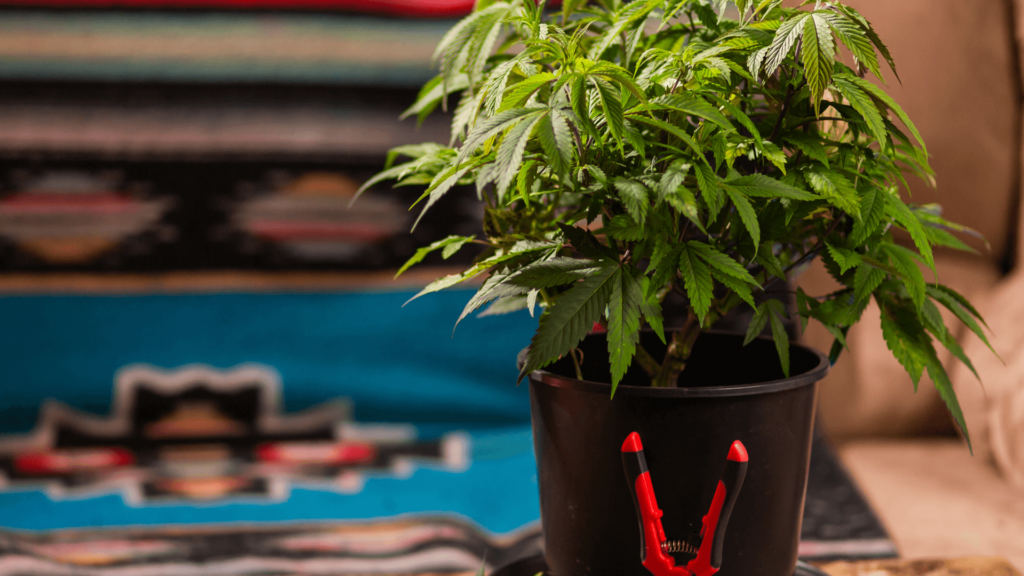So you’ve embarked on the journey of growing your own cannabis plant – kudos to you! Whether you’re a seasoned professional or a newbie, nothing compares to the thrill of growing your own stash.
As you venture into this green realm, you may wonder what kind of yield to expect from your plant. Estimating one plant’s yield is not an exact science and depends on several factors.
We’ll help you understand exactly what affects your plant’s growth and what you can do to maximize your yield.

When we talk about the yield of a cannabis plant, we’re referring to the amount of usable cannabis that you can harvest from a single plant. Optimizing your plant’s yield involves working on several fronts at once. Some elements that affect the size of your yield are:
A very broad average of the yield of one indoor, medium-sized, healthy weed plant is a quarter pound weed or 112 grams. One outdoor, medium-sized, healthy weed plant will, on average, produce half a pound of weed or 224 grams.
Before you eagerly rush off and start preparing to grow your own leafy jungle, remember to research how many plants you can legally grow in your state or country. In most states in the USA, you can legally grow up to 6 plants and own a few ounces of weed.
While the federal government has still outlawed cannabis, each state has its own laws around cannabis possession and use.
Estimating your yield potential requires a mixture of experience, science, and a dash of intuition! There are various techniques for estimating your yield while growing your plant.
By combining these different approaches, you’ll be better equipped to estimate your cannabis yield and make informed decisions throughout the growing process
The factors determining your weed yield are the same as those to consider when estimating your yield potential. But you can optimize each of these factors to give you the most bang for your buck.
The genetic makeup of your chosen cannabis strain plays a pivotal role in determining your ultimate yield. Some strains are naturally more prolific, producing larger and denser buds.
Sativa-dominant strains have a bigger yield with shorter, more solid buds. On the other hand, indica-dominant strains produce a lower yield with longer, more feathery buds. But this is a very broad generalization and you will indica-forward strains that will far surpass their sativa-dominant friends.
Research different strains to find one that suits your cultivation goals, whether that be maximizing yield, potency, or a specific flavor profile.
The medium in which your cannabis plant grows significantly affects its development. The two most popular growing mediums are soil and hydroponics. Each one has its benefits and downfalls, so choosing one is really up to you.
Soil provides a more natural environment that is already rich in nutrients. These ingredients are freely available in most soils, but they take time to be absorbed. Live organisms in soil convert raw nutrients to plant-soluble food.
Growing your cannabis plant in soil is more affordable, and more eco-friendly, and there is less room for any nutrient errors. Plants grow more slowly in soil, they are exposed to naturally occurring pests, and challenges with the pH levels take longer to correct.
Setting up a hydroponics system is a lot more expensive upfront, as all the gear is specialized. This means that scaling your cultivation project is not as easy as a soil garden. But plants grow faster with this method, and it is a lot easier and faster to correct any nutrient deficiencies or pH imbalances.
Correcting issues relating to pH and nutrients in a hydroponic system is fast and easy. But this also means that over-correcting any issues happens more often. This could lead to the opposite problem: nutrient lockout.
Light is the most important energy source for all plants, and it plays a crucial role in photosynthesis. The cannabis plant does the best with plenty of full sunlight. So the type of lighting you choose will significantly affect your plant’s yield.
If you choose to grow an outdoor garden, you don’t have to think much about lighting. Your garden will make use of the sun’s natural light. If you are living in a country with a lot of natural light, then your plants will thrive.
Indoor gardeners have a few more choices at their fingertips. Two popular options are High-Intensity Discharge (HID) and Light Emitting Diodes (LED) lamps.
HIDs are a staple in the industry and have been around for a long time because of their strength of emissions. They promote vigorous growth and ample flowers.
If you are looking to light a smaller garden, LEDs might be better suited to you because they are more energy efficient. LED lamps are often spectrum tunable, meaning that you can adjust the color of your light for the different stages of your plant’s growth.
Cannabis plants do blossom with plenty of light, but be careful not to overdo it or they might burn. If you are cultivating an indoor garden, try to match up the combined power of your lighting with the amount of plants.
Whether you choose to grow your cannabis outside or indoors, maintaining a relatively consistent environment is crucial for a successful harvest. When your plant’s environment is stable, it minimizes stress and helps promote robust growth.
For growers, cultivating outdoors and maintaining a stable environment can be difficult. Sudden heat waves or cold fronts are out of your control and can damage the health of your plant. Growing cannabis in a greenhouse can help to mitigate these factors.
One of the biggest advantages of indoor gardens is that they offer full control over your plant’s environment. You can monitor the amount of light, the amount of nutrients, and the space that your plants receive. Just be sure to ventilate your indoor garden so that it has a constant flow of air to prevent mold.
Maintaining the right temperature and humidity levels is vital throughout the plant’s life cycle. Cannabis plants prefer temperatures between 70 – 85°F (or 21 – 29°C) during the day and are slightly cooler during the night.
Humidity levels also play a significant role in your weed plant’s yield. During the vegetative stage, cannabis plants thrive at a higher humidity level of approximately 40% – 70%. As the plants transition to the flowering phase, gradually reduce the humidity to 40%-50%.
Controlling humidity prevents issues like mold and bud rot, especially in the denser bud formations.
Like many of these aspects affecting your weed plant’s yield, getting the optimal temperature and humidity is a balancing act. Hot temperatures, especially coupled with high humidity, can create a breeding ground for pests and diseases.
On the other hand, low humidity can lead to the plant drying out through excessive transpiration. This will stress your plant out and lower your yield.
Nutrients play a crucial role in cannabis growth and development, influencing various aspects of plant health, vigor, and ultimately yield.
Providing the right balance of nutrients throughout the plant’s life cycle is essential for maximizing yield potential.
Different stages of growth require different nutrient ratios, so it’s important to follow a feeding schedule appropriate for the cultivation method you choose.
The pH level of the growing medium influences nutrient uptake. Cannabis plants prefer a slightly acidic pH range of 6.0 to 6.5 for optimal nutrient uptake. pH levels outside of this range can lead to nutrient deficiencies or toxicities, affecting plant growth.
Another way to help your plant produce a larger and higher quality yield is to employ certain growing techniques. There are various methods of achieving this during the vegetative growth stage.
Timing is crucial when harvesting weed. Always keep an eye on the trichomes of the plant. The trichomes are those tiny, bead-like structures on the end of the buds. They contain most of the cannabinoids, terpenes, and other compounds responsible for the effects and aroma of cannabis.
When the trichomes change color from clear to cloudy or amber, then the plant is ready to harvest. Harvesting during the cloudy trichome stage is preferred for a balanced combination of THC and other cannabinoids, providing both cerebral and physical effects.
Measuring your yield accurately is a vital part of the cultivation process.
To get an accurate yield measurement, avoid weighing fresh flower. During the drying process, nugs will lose 70% – 80% of their weight to moisture evaporation.
Once dried, carefully weigh your cannabis buds using a scale calibrated for accuracy. This measurement represents the dry weight of your harvest and provides a more reliable indication of your yield.
It is almost impossible to know exactly how much weed you will harvest from one plant. Your yield depends on several factors. The better you become at mastering these factors, the more your plants will reward you.
If your first harvest disappoints you, don’t lose heart! All the best gardeners took years to hone their craft.
But in order to know what high-quality bud smells like and tastes like, you must have some frame of reference. At Embarc, we offer only the finest cannabis for you to indulge in!
